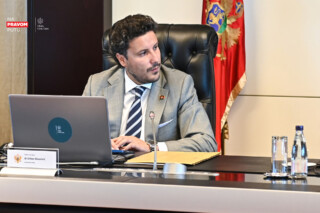Montenegro will shorten self-isolation for people who tested positive for the coronavirus to 14 days, just as many countries in the region and beyond did, Dr Senad Begić of the Public Health Institute told CdM.
- Key moments from the interview with Mr Begić –
CdM: Yesterday’s press conference of the National Coordination Body (NCB) announced the possibility of cutting self-isolation in line with the recommendations of the World Health Organization (WHO). What is it about and what is going to happen in Montenegro in this context?
DR BEGIĆ: We are witnesses that the time necessary for the isolation of patients and contacts in some countries changed – first we had seven days, then over 10 to even 28 days… and in the end, most countries introduced 14 or 21 days of self-isolation. The latest scientific evidence indicates that the infectivity of patients is significantly shorter than originally thought, and that patients are infectious a day or two before showing first symptoms, that the infectivity increases with the symptoms, i.e. it’s highest during the first two days, after which it gradually drops and disappears in the first 10 days of the disease in patients who had mild symptoms. The infectivity of asymptomatic cases lasts even shorter – which is good news for all health workers.
Having in mind these scientific researches, the latest recommendations of the U.S. Center for Prevention of Diseases suggest that infected patients showing no signs of Covid-19 can end their self-isolation after 10 days without any additional checks.
…
In any case, self-isolation and recovery time of all patients must last for at least 14 days.
CdM: Croatia has already amended its protocol in this sense. Are we going to do the same and if yes – when?
DR BEGIĆ: From the very beginning of the coronavirus outbreak, we have always tried to keep up with the latest scientific researches and recommendations, and in accordance with them, we were amending the guidelines and recommendations. The same applies to all other public health agencies, including the Croatian Public Health Institute. However, what characterized our approach is perhaps a greater dose of conservatism in treatment, which was a reflection of what was happening on the field, but also a reflection of the health and social system itself, which could not withstand a large and sudden influx of patients.
…
You mentioned Croatia. Not only Croatia introduced the new methodology. In addition to it, almost all countries of the European Union, the United States of America, Japan, the Philippines have done the same … And some have even slightly more liberal criteria than these, such as England, i.e. the United Kingdom.
CdM: Does this mean that people, who are e.g. 16 days in isolation after positive test for Covid-19, will be able to get out of isolation and move freely without the possibility of endangering others?
DR BEGIĆ: The latest recommendations indicate that asymptomatic patients, after at least 14 days of isolation, are not dangerous for their environment, i.e. they don’t have to self-isolate after 14 days.
For symptomatic patients, even if they showed only mild symptoms, self-isolation can end only after 14 days from date of taken sample, i.e. 14 days after positive test for Covid-19 plus at least 3 additional days without symptoms.
…
CdM: Why are there such changes in the attitudes of the health authorities of various countries? Was it not possible at the beginning to take a stand and stick to a single stance?
DR BEGIĆ: Key features of any mass disease are many unknown things and the impossibility of accurately predicting the development of the situation on the field, which, in fact, depends on a great many of variables. It is even more expressed with unknown pathogens such as the new coronavirus.
…
As the scientific proofs improved, recommendations and guidelines were changing, which was something that we expected. And it all aimed to align the public health operations in order to make them more useful and in line with the latest scientific data and proofs.
…
Specifically, when it comes to our today’s topic, what has confused us epidemiologists around the world is the fact that many patients had a positive PCR finding long after the disease was diagnosed. Initially, this result was explained by the fact that patients had a live virus in the respiratory system. However, numerous studies have proven that it is not an infectious virus, but most likely parts of the genetic material of the virus that the PCR test recognizes.
…




